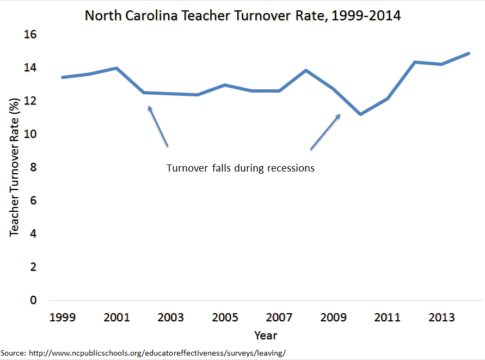According to national data, four out of ten teachers will leave the classroom within five years. But turnover isn’t evenly distributed. The highest turnover happens in high poverty urban and rural public schools. In 2004-05, close to half of all public school teacher turnover happened in just one quarter of all public schools.
What’s more, turnover varies even within a district. A recent report from the National Council on Teacher Quality (NCTQ) tracked teacher retention across the Miami-Dade County Public Schools as one of several indicators correlated with teacher quality. NCTQ found that a sizeable portion of the county’s turnover took place in two particular low-income voting districts, and that many of the teachers who resigned left after only teaching a few years in the classroom. In the geographic region with the most turnover (voting district 2), over a third of all teachers who resigned had two or fewer years of experience, and over half had fewer than five years in the classroom. Florida makes similar statewide turnover assumptions about its teachers and assumes that over 60 percent of teachers will leave after 5 years. The graph below shows how teacher turnover differs within the Miami-Dade Public schools.
Teacher Resignations in the Miami-Dade Public Schools (by voting district)

Click to enlarge
In terms of retirement, the Miami-Dade County Public Schools teachers in voting districts 1 and 2 are particularly vulnerable if they remain in the traditional state pension system. Any teacher that leaves the classroom before eight years will not qualify for a pension, and Florida assumes that roughly three-quarters of teachers won’t qualify. However, since 2002, teachers can choose to opt into a 401k-style retirement plan instead of a traditional pension. Teachers who choose the 401k-style retirement plan will automatically qualify for their account savings after just one year, and many teachers seem to prefer the plan according to one study. The 401k-style plan benefits are portable and better for shorter-term and mobile teachers, while the traditional pension plan are better for teachers who stay beyond eight years. Teachers in voting districts 1 and 2 would be better off choosing a 401k-style plan where they could leave with retirement account savings rather than nothing.
Having flexible plan options can give mobile teachers, especially in urban and rural public schools where turnover is high, more secure retirement benefits. School districts should additionally take a role in clearly explaining benefits options to teachers.
—Leslie Kan
This post originally appeared on TeacherPensions.org





